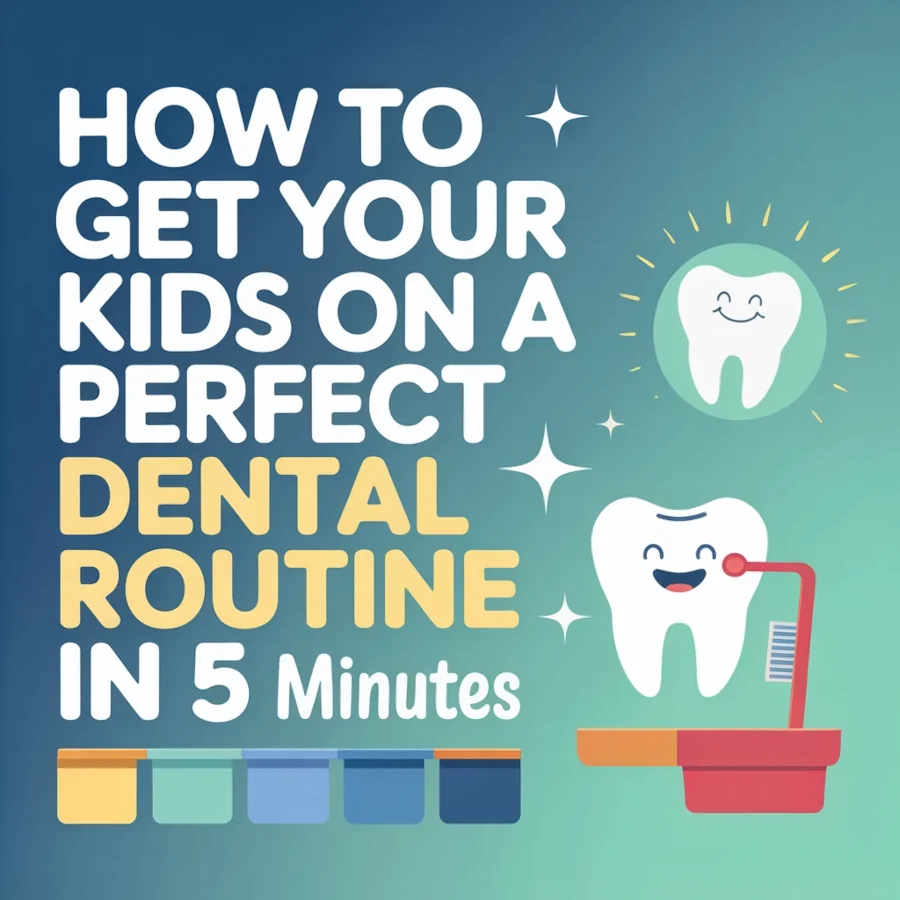How to Get Your Kids on a Perfect Dental Routine in 5 Minutes
How to Get Your Kids on a Perfect Dental Routine in 5 Minutes
Getting your kids to maintain proper oral hygiene doesn’t have to be a daily battle. With the right approach, you can establish a comprehensive dental routine that takes just five minutes and sets your children up for a lifetime of healthy teeth and gums. The key lies in creating a structured, engaging process that children actually want to participate in rather than resist.
Research consistently shows that children who develop strong oral hygiene habits early experience significantly fewer dental problems throughout their lives. As a result, parents who invest time in establishing these routines can potentially save thousands of dollars in future dental treatments while ensuring their children’s long-term health and confidence.
The Foundation of Successful Dental Routines
Children thrive on consistency and structure. When you establish a clear, predictable routine, kids know what to expect and are more likely to cooperate. The five-minute framework works because it’s long enough to be thorough but short enough to hold a child’s attention span without causing frustration or resistance.
Studies show that children as young as two years old can begin participating in their own oral care, though they’ll need supervision and assistance until around age six or seven. By starting early and maintaining consistency, you’re not just cleaning teeth – you’re building neural pathways that make good oral hygiene feel automatic and natural.
Breaking Down the Perfect 5-Minute Routine
Step 1: Brushing (2 Minutes)
The foundation of any dental routine is proper brushing technique for a full two minutes. This timeframe allows for adequate plaque removal from all surfaces of the teeth. To make these two minutes engaging rather than tedious, consider incorporating music or movement into the process.
Many children respond well to brushing to the beat of their favorite song. You can create a special “brushing playlist” with songs that are exactly two minutes long, or use dental apps like Brush DJ that play music while timing the brushing session. The key is making this time feel special rather than like a chore.
Demonstrate proper technique by brushing your own teeth alongside your child. Children learn best through modeling, and when they see that tooth brushing is important enough for adults to do consistently, they’re more likely to view it as a normal, necessary part of daily life.
Step 2: Flossing (1-2 Minutes)
Flossing removes plaque and food particles from areas that even the best toothbrush can’t reach – the spaces between teeth and along the gum line. Unfortunately, many parents skip this step because they assume it’s too difficult for children or because they don’t floss consistently themselves.
Children as young as five can begin learning to floss with parental guidance and child-friendly tools. Floss picks or pre-threaded flossers are often easier for small hands to manipulate than traditional string floss. Start by helping your child floss a few teeth, then gradually allow them to take over more of the process as their dexterity improves.
To make flossing more engaging, explain it in terms children understand: “flossing frees the food that the toothbrush missed” or “we’re cleaning the secret hiding spots between your teeth.” Visual demonstrations using props like marshmallows or building blocks can help children understand why this step matters.
Step 3: Rinse and Final Check (30-60 Seconds)
The final step involves a thorough rinse with water to remove loosened debris and remaining toothpaste. This step also helps children develop the habit of clearing their mouth completely after oral care.
End each session with a “smile check” – have your child look in the mirror and show off their clean teeth. This creates a positive conclusion to the routine and reinforces the connection between good oral care and the results they can see and feel.
Making the Routine Engaging and Sustainable
Character-Themed Supplies
Children often identify strongly with favorite characters from movies, books, or television shows. Leveraging this natural interest by providing character-themed toothbrushes and toothpaste can transform resistance into enthusiasm. When a child gets to brush their teeth with a Spider-Man toothbrush or Frozen-themed toothpaste, the routine becomes associated with something they already enjoy.
Rotate these supplies periodically to maintain novelty and interest. Consider letting your child help choose their dental supplies during shopping trips, giving them ownership over the process and tools they use.
Reward Systems and Tracking
Visual progress tracking appeals to children’s natural desire for achievement and recognition. Create a brushing calendar featuring your child’s favorite themes, and add stickers or stamps each time they complete their routine properly. After accumulating a certain number of successful days, provide a small, non-food reward.
The reward system should focus on consistency rather than perfection. If your child misses a day or doesn’t brush as thoroughly as usual, avoid harsh consequences. Instead, gently redirect them back to the routine and celebrate when they get back on track.
Family Participation
Making oral hygiene a family affair removes the feeling that children are being singled out for an unpleasant task. When the entire family brushes together, it becomes a shared activity rather than something imposed on children by adults.
Consider designating specific times for family brushing sessions, such as after breakfast or before bedtime stories. This approach also ensures that parents model good oral hygiene consistently, reinforcing the importance of these habits through action rather than just words.
Overcoming Common Challenges
Resistance and Refusal
Some children will initially resist the routine, especially if previous oral care experiences have been rushed, uncomfortable, or inconsistent. Patience and persistence are essential during this adjustment period.
If your child refuses to participate, avoid turning the situation into a power struggle. Instead, try adjusting your approach – perhaps the toothbrush is uncomfortable, the toothpaste flavor is unpleasant, or the timing conflicts with other activities they enjoy.
Consider allowing children to brush your teeth while you brush theirs, turning the activity into a game of mutual care. This approach often reduces resistance while maintaining the essential goal of thorough cleaning.
Time Management
Many families struggle to find five uninterrupted minutes for oral care, particularly during busy morning routines. The solution often involves adjusting family schedules rather than shortening the dental routine.
Consider completing the full routine in the evening when schedules are typically less rushed, and doing a shorter morning routine focused primarily on brushing. Alternatively, establish the routine earlier in the morning or immediately after dinner rather than right before bedtime when children are often tired and less cooperative.
The Long-Term Benefits
Health Advantages
Children who maintain consistent oral hygiene routines experience significantly lower rates of tooth decay, gum disease, and orthodontic complications. The fluoride in toothpaste strengthens tooth enamel, while regular plaque removal prevents the bacterial buildup that leads to cavities and gum inflammation.
Research indicates that good oral health in childhood correlates with better overall health outcomes throughout life. The mouth serves as a gateway to the rest of the body, and maintaining oral health reduces the risk of various systemic conditions later in life.
Financial Implications
The financial benefits of prevention cannot be overstated. A single cavity filling typically costs between $100-$250, while pediatric crowns can range from $500-$1,500 depending on location. More complex treatments resulting from neglected oral health can cost thousands of dollars.
When you consider that establishing a five-minute daily routine can prevent many of these expensive interventions, the time investment becomes clearly worthwhile from both health and financial perspectives.
Building Life Skills
Beyond oral health, this routine teaches children valuable life skills including responsibility, self-care, and the importance of consistency in maintaining personal health. These lessons extend far beyond dental care and contribute to overall personal development and self-discipline.
Essential Rules for Success
Establish and maintain a firm “no snacks after brushing” rule, particularly for the evening routine. Sugary or starchy foods consumed after oral care provide fuel for bacteria throughout the night, undermining the cleaning you’ve just completed. Water should be the only consumable allowed after the final brushing session of the day.
If your child requests snacks or drinks before bed, shift snack time to earlier in the evening, creating a clear separation between eating and oral care. This boundary helps establish the routine as the definitive end to the day’s food consumption.
Consistency proves more valuable than perfection. A routine maintained most days will yield better results than a perfect routine performed sporadically. Focus on establishing the habit first, then refine the technique and thoroughness over time.
When children understand that this five-minute investment protects their teeth, prevents pain, and saves money that can be spent on more enjoyable activities, they often become willing participants rather than reluctant subjects. The key lies in presenting oral care as an investment in their future rather than simply another rule they must follow.





